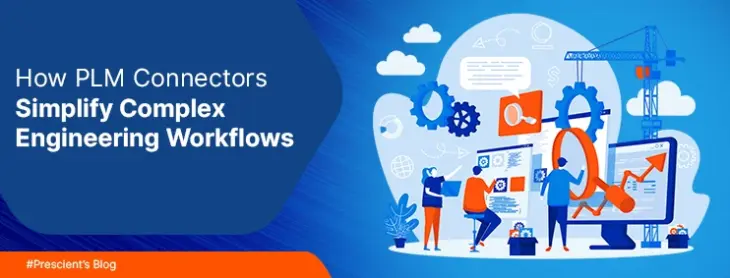How PLM Implementation Connectors Simplify Complex Engineering Workflows
Engineering Teams Are Drowning in System Silos Have you ever spent hours just finding the right version of a design file? You’re not alone. As products become more complex, engineering teams often juggle disconnected tools like CAD, ERP, MES, and PLM. Managing data across these platforms without a unified flow leads to version control issues, duplicated efforts, and delays. A McKinsey report highlights that engineers spend up to 40% of their time searching for project data instead of solving engineering problems. This is where intelligent PLM implementation connectors come in they don’t just link software. They streamline chaos into clarity. The Real Cost of Disconnected Engineering Systems When systems don’t talk to each other, it creates invisible bottlenecks that hurt your business. Here’s how: According to Lucent Innovation, manufacturing companies can lose 12–15% of productivity annually due to poor data integration across platforms. The frustration? These are smart people working in a broken system. Not because the tools are bad, but because they’re not connected in the right way. What Are PLM Connectors and Why Should You Care? A PLM connector is like a translator between your critical systems CAD, ERP, MES, CRM, and more. It makes sure every piece of product information flows seamlessly and accurately across your organisation. Think of it like this: This isn’t automation for the sake of it. It’s smart data management that reduces engineering errors, accelerates workflows, and keeps teams in sync. How PLM Connectors Simplify Complex Workflows 1. Bridge Between Design and Manufacturing Design changes often don’t reach manufacturing on time. With real-time engineering collaboration using connectors, manufacturing gets automatic updates from PLM systems preventing costly mistakes on the shop floor. 2. Accelerated Product Lifecycle Management Setup PLM connectors enable a faster and more dependable product lifecycle management setup by avoiding manual configurations between tools. This speeds up implementation and keeps product data consistent across departments. 3. Improved Cross-Team Collaboration Sales, service, quality, and engineering all view the same product records. No more emailing spreadsheets or misaligned file versions. Everyone works with the most up-to-date information. 4. Supports Cloud-Based Scalability Many companies are moving toward cloud-based PLM integration. Connectors simplify this shift by ensuring legacy systems and modern cloud tools still communicate effectively. 5. Paves the Way for AI in Engineering AI applications in manufacturing like predictive design and anomaly detection rely on clean, connected data. AI in PLM for manufacturing only works when connectors break the silos and enable smart algorithms to see the full picture. When Should You Use a PLM Connector? You should consider it if: Prescient Technologies recommends PLM connectors during the early stages of implementation. This makes multi-system PLM integration smoother, cheaper, and less prone to rework. Prescient Technologies’ PLM Connectors: What Makes Them Different? Prescient’s connectors are built with over two decades of CAD/PLM software expertise. Unlike generic integration tools, these are: The connectors seamlessly integrate with other Prescient products like factoryCONNECT, machineCONNECT, and powerCONNECT, allowing full digital factory visibility. “Digital engineering needs digital connections. Without them, you’re just automating chaos.” – Engineering Tech Council, 2024 TechNewsWorld Report Key Takeaways Prescient’s custom connectors are built for real-time engineering collaboration and enterprise scalability. Engineering teams waste time navigating disconnected systems. PLM connectors bridge gaps between CAD, ERP, MES, and more. They speed up PLM implementation, improve accuracy, and reduce manual rework. These tools enable cloud-based PLM integration and support future-ready AI use cases.
Read MoreWhy Now Is the Right Time to Upgrade from RAC to AWC in Teamcenter
Many companies still rely on RAC (Rich Client) in Teamcenter. It has served them well for years. However, the software is becoming outdated. It struggles to meet modern demands. Teams need better performance, more scalability, and easier integration. AWC (Active Workspace Client) offers a solution to these issues. It is the modern alternative to RAC. Upgrading now can position your business for success. This blog explains why upgrading from RAC to AWC is the right decision. We will also discuss how Teamcenter Data Migration can make the transition smoother. Before: The Challenges of Using RAC in Teamcenter Although RAC has been a reliable tool, it comes with significant drawbacks today. As businesses grow, so do their data and system needs. RAC was not designed for modern requirements. Let’s look at the key challenges that businesses face with RAC. 1. Limited Scalability and Performance RAC struggles with large datasets. As data grows, performance slows down. Teams working with big datasets often experience delays. These delays can lead to frustration and decreased productivity. RAC was not built to handle the increasing amount of data that businesses deal with today. AWC, on the other hand, is designed for better performance and scalability. It can grow with your business and adapt to changing needs. 2. Complex User Interface and Integration Issues RAC’s user interface is not easy for everyone to navigate. New users must undergo extensive training. This can be time-consuming and costly. The interface is also not very intuitive. Users often need assistance to understand basic functions. Teamcenter integration issues are common when trying to link RAC with modern business tools. Many companies find that integrating RAC with other systems, such as ERP or cloud tools, is difficult. AWC simplifies this process. It uses a more intuitive, modern interface that is easier for everyone to learn. 3. High Maintenance Overheads Maintaining RAC is not cheap. Companies spend time and money updating the system. They also need to deal with constant troubleshooting. IT teams are often bogged down by the need for updates, bug fixes, and security patches. This takes resources away from more strategic tasks. AWC, however, reduces these maintenance costs. The web-based system is easier to manage. Updates happen seamlessly, and IT teams don’t need to invest as much time in maintenance. After: Benefits of Upgrading to AWC Upgrading from RAC to AWC brings numerous benefits. The transition is smooth with Teamcenter Data Migration, and businesses quickly see improvements in their systems. Here are the key advantages of AWC over RAC. 1. Improved User Experience AWC offers a much more modern user experience. It uses a web-based interface, which is easy to access from anywhere. Users can log in from their office, home, or even on the go. This flexibility makes it easier for teams to collaborate and stay productive. AWC’s interface is also simpler and more intuitive. Employees spend less time learning how to use it and more time on their work. This improves overall efficiency and reduces training costs. 2. Better Performance AWC handles large amounts of data much better than RAC. The performance of your Teamcenter system improves with AWC. It is built to manage bigger datasets and more complex workflows without slowing down. Teams can quickly retrieve and work with data, no matter how much it grows. This means faster decision-making and better overall productivity. 3. Seamless Integration AWC is much better at integrating with other systems. Whether it’s ERP, CRM, or cloud tools, AWC can connect with them easily. This is a huge advantage over RAC, which often faces challenges when integrating with modern software. When different systems work together seamlessly, teams spend less time transferring data manually. Workflow becomes smoother and more efficient. 4. Lower IT Overheads AWC reduces the need for IT intervention. Since it’s web-based, there’s no need for software installation on every user’s machine. This saves IT departments time and money. Updates are handled centrally, so IT teams don’t need to spend time pushing updates to every workstation. AWC’s easy maintenance and cloud integration reduce the burden on IT staff, freeing them up for more important tasks. Bridge: How to Achieve a Smooth Transition with Teamcenter Data Migration The idea of migrating from RAC to AWC may seem daunting. But the Teamcenter Data Migration process can make it easier. With the right plan, businesses can transition smoothly to AWC without disrupting day-to-day operations. 1. Data Validation One of the most important parts of the migration is PLM data validation. This ensures that no data is lost during the move from RAC to AWC. Migration experts will verify that all data is transferred correctly. Data validation helps guarantee that your new system works as expected. It also ensures that your business operations continue without interruptions. This step is important for maintaining data integrity. 2. Planning the Migration Process A successful migration starts with careful planning. The first step is to assess the current system. What data needs to be moved? What integrations must be set up? By identifying key integration points early, businesses can avoid issues down the line. A detailed plan will also help minimize downtime during the transition. Professional migration services can assist with this. They will ensure a smooth transition by managing each step of the migration process. 3. User Training Although AWC is easier to use than RAC, training is still necessary. Employees will need to familiarize themselves with the new system. Training sessions should be scheduled to help staff learn how to navigate AWC efficiently. Proper training make sure that employees are comfortable using the new system right away. It will help them make the most of AWC’s features and improve their productivity. 4. Leveraging Cloud-Based Solutions AWC works well in cloud environments. Many businesses are moving their PLM systems to the cloud for better flexibility and scalability. Cloud-based PLM solutions reduce the need for on-premise IT infrastructure. They also improve data accessibility. Teams can access data and applications from anywhere, anytime. AWC’s cloud compatibility allows businesses to
Read More
